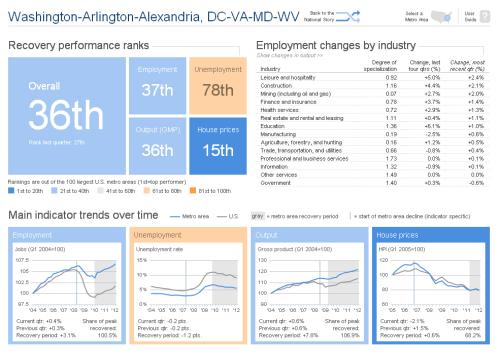One has only to look at the latest MetroMonitor to start getting seriously freaked out about the growing likelihood that the Senate won’t deliver the additional tranche of emergency state aid that President Obama last week called critical to preventing the layoffs of thousands of teachers and government workers.
My colleague Howard Wial has already noted that the present economic recovery looks substantially “more fragile than it did just a few months ago” so I’ll just add that the anxiety pervading national discussions gets really acute when you peer into, say, the local metropolitan-area economies of the Mountain West. Out there, Brookings Mountain West’s Mountain Monitor shows that employment growth ceased in the first quarter in the large metros of the Intermountain West while even output growth slowed. Unemployment, for its part, is still inching up in every large metro out there except Denver.
All of which underscores why it is so disconcerting that state aid negotiations foundered again late last week. With growth slowing, the wind-down of the original $787 billion federal stimulus package beginning, and the federal homebuyer tax credit expired as of April, it seems foolhardy to stint on additional stimulus right now–particularly stimulus routed through that most direct delivery system of state or local government aid that will reduce government layoffs.
What’s so important about state and local aid? Well, federal, state, and local government can make up 17 or 18 percent of a state’s or metro’s employment. Local government alone accounts for one in 10 non-farm jobs in large metros, as Chris Hoene of the National League of Cities and I noted last winter in a paper on the coming local government fiscal crisis. In fact, the new Mountain Monitor notes that high levels of federal, state, and local government employment have been statistically correlated with greater economic stability over the course of the recession in the Mountain region metros.
Hence the important takeaway: Leaving states and localities to cope alone with the deepening state and local fiscal crisis looks very much like undercutting one of the very few remaining props of the quite shaky local and national economic recovery. Note as the Center on Budget and Policy Priorities does that some 46 states are facing budget gaps that will require them to cut spending or raise taxes to the tune of a total of $180 billion in 2011. Those adjustments will either place a new drag on household and business spending or erase thousands of jobs and billions of dollars’ worth of demand, purchasing, and contracting. They will depress demand, and suck energy out of the recovery. Which is to say: These state budget adjustments (and local ones like them) are the equivalent of a “massive anti-stimulus,” as Ezra Klein nicely puts it. Just as Washington is wondering why the recovery remains shaky states and local governments are preparing to deliver another blow.
And so the Senate needs to think carefully now. Inaction is in fact action of a particularly dangerous sort. To be sure, concerns about the deficit are legitimate and will need to move to the forefront once the recovery is secure. However, a huge chunk of the nation’s present budgetary mess owes to the lousy economy, the reanimation of which holds out the best route to budgetary balance. And so it makes no sense to scratch the $24 billion being discussed in the Senate for Medicaid support to states (and the stay on further state layoffs it will offer) in service of a precipitous gesture toward fiscal rectitude. If Congress doesn’t act to limit deep reductions for states, schools, hospitals, and nursing homes, the states will themselves have to act, and it won’t be pretty.






Commentary
Stimulus, Anti-Stimulus, and the Metropolitan Facts
June 21, 2010